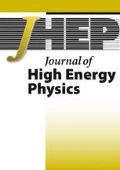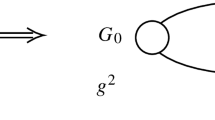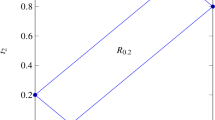Abstract
We study effective quiver gauge theories arising from a stack of D3-branes on certain Calabi-Yau singularities. Our point of view is a first principle approach via open topological string theory. This means that we construct the natural A ∞-structure of open string amplitudes in the associated D-brane category. Then we show that it precisely reproduces the results of the method of brane tilings, without having to resort to any effective field theory computations. In particular, we prove a general and simple formula for effective superpotentials.
Similar content being viewed by others
References
M. Aganagic and C. Beem, The geometry of D-brane superpotentials, arXiv:0909.2245 [SPIRES].
M. Alim et al., Hints for off-shell mirror symmetry in type-II/F-theory compactifications, arXiv:0909.1842 [SPIRES].
M. Alim, M. Hecht, P. Mayr and A. Mertens, Mirror symmetry for toric branes on compact hypersurfaces, JHEP 09 (2009) 126 [arXiv:0901.2937] [SPIRES].
S.K. Ashok, E. Dell’Aquila, D.-E. Diaconescu and B. Florea, Obstructed D-branes in Landau-Ginzburg orbifolds, Adv. Theor. Math. Phys. 8 (2004) 427 [hep-th/0404167] [SPIRES].
P.S. Aspinwall, Topological D-branes and commutative algebra, hep-th/0703279 [SPIRES].
P.S. Aspinwall and L.M. Fidkowski, Superpotentials for quiver gauge theories, JHEP 10 (2006) 047 [hep-th/0506041] [SPIRES].
P.S. Aspinwall and A.E. Lawrence, Derived categories and zero-brane stability, JHEP 08 (2001) 004 [hep-th/0104147] [SPIRES].
M. R. Ballard, Sheaves on local Calabi-Yau varieties, arXiv:0801.3499.
M. Baumgartl, I. Brunner and M.R. Gaberdiel, D-brane superpotentials and RG flows on the quintic, JHEP 07 (2007) 061 [arXiv:0704.2666] [SPIRES].
M. Baumgartl and S. Wood, Moduli Webs and Superpotentials for Five-Branes, JHEP 06 (2009) 052 [arXiv:0812.3397] [SPIRES].
A.A. Beĭlinson, Coherent sheaves on P n and problems in linear algebra, Funktsional. Anal. i Prilozhen. 12 (1978) 68.
M. Bender and S. Mozgovoy, Crepant resolutions and brane tilings II: tilting bundles, arXiv:0909.2013.
A. Bondal and M. van den Bergh, Generators and representability of functors in commutative and noncommutative geometry, Mosc. Math. J. 3 (2003) 1 [math/0204218].
A.I. Bondal, Representations of associative algebras and coherent sheaves, Izv. Akad. Nauk SSSR Ser. Mat. 53 (1989) 25.
T. Bridgeland, T-structures on some local Calabi-Yau varieties, math/0502050.
N. Broomhead, Dimer models and Calabi-Yau algebras, arXiv:0901.4662 [SPIRES].
I. Brunner, M.R. Douglas, A.E. Lawrence and C. Romelsberger, D-branes on the quintic, JHEP 08 (2000) 015 [hep-th/9906200] [SPIRES].
F. Cachazo, B. Fiol, K.A. Intriligator, S. Katz and C. Vafa, A geometric unification of dualities, Nucl. Phys. B 628 (2002) 3 [hep-th/0110028] [SPIRES].
N. Carqueville, Matrix factorisations and open topological string theory, JHEP 07 (2009) 005 [arXiv:0904.0862] [SPIRES].
K. Costello, Topological conformal field theories and Calabi-Yau categories, math/0412149.
A. Craw and G. G. Smith, Projective toric varieties as fine moduli spaces of quiver representations, Amer. J. Math. 130 (2008) 1509 [math/0608183].
M.R. Douglas, D-branes, categories and N = 1 supersymmetry, J. Math. Phys. 42 (2001) 2818 [hep-th/0011017] [SPIRES].
M.R. Douglas, S. Govindarajan, T. Jayaraman and A. Tomasiello, D-branes on Calabi-Yau manifolds and superpotentials, Commun. Math. Phys. 248 (2004) 85 [hep-th/0203173] [SPIRES].
M.R. Douglas and G.W. Moore, D-branes, quivers and ALE instantons, hep-th/9603167 [SPIRES].
B. Feng, A. Hanany and Y.-H. He, D-brane gauge theories from toric singularities and toric duality, Nucl. Phys. B 595 (2001) 165 [hep-th/0003085] [SPIRES].
B. Feng, A. Hanany and Y.-H. He, Phase structure of D-brane gauge theories and toric duality, JHEP 08 (2001) 040 [hep-th/0104259] [SPIRES].
B. Feng, A. Hanany, Y.-H. He and A.M. Uranga, Toric duality as Seiberg duality and brane diamonds, JHEP 12 (2001) 035 [hep-th/0109063] [SPIRES].
S. Franco, A. Hanany, K.D. Kennaway, D. Vegh and B. Wecht, Brane dimers and quiver gauge theories, JHEP 01 (2006) 096 [hep-th/0504110] [SPIRES].
S. Franco et al., Gauge theories from toric geometry and brane tilings, JHEP 01 (2006) 128 [hep-th/0505211] [SPIRES].
M. Futaki and K. Ueda, A-infinity categories associated with dimer models, arXiv:0912.1656.
S. Govindarajan and H. Jockers, Effective superpotentials for B-branes in Landau-Ginzburg models, JHEP 10 (2006) 060 [hep-th/0608027] [SPIRES].
T.W. Grimm, T.-W. Ha, A. Klemm and D. Klevers, The D5-brane effective action and superpotential in N = 1 compactifications, Nucl. Phys. B 816 (2009) 139 [arXiv:0811.2996] [SPIRES].
T.W. Grimm, T.-W. Ha, A. Klemm and D. Klevers, Computing brane and flux superpotentials in F-theory compactifications, arXiv:0909.2025 [SPIRES].
T.W. Grimm, T.-W. Ha, A. Klemm and D. Klevers, Five-brane superpotentials and heterotic/F-theory duality, arXiv:0912.3250 [SPIRES].
D.R. Gulotta, Properly ordered dimers, R-charges and an efficient inverse algorithm, JHEP 10 (2008) 014 [arXiv:0807.3012] [SPIRES].
A. Hanany, C.P. Herzog and D. Vegh, Brane tilings and exceptional collections, JHEP 07 (2006) 001 [hep-th/0602041] [SPIRES].
A. Hanany and K.D. Kennaway, Dimer models and toric diagrams, hep-th/0503149 [SPIRES].
M. Herbst, K. Hori and D. Page, Phases of N = 2 theories in 1 + 1 dimensions with boundary, arXiv:0803.2045 [SPIRES].
M. Herbst, C.-I. Lazaroiu and W. Lerche, Superpotentials, A ∞ relations and WDVV equations for open topological strings, JHEP 02 (2005) 071 [hep-th/0402110] [SPIRES].
L. Hille and M. van den Bergh, Fourier-Mukai transforms, in Handbook of tilting theory, London Math. Soc. Lecture Note Ser. volume 332, Cambridge University Press, Cambridge U.K. (2007), page 147.
C. Hofman and W.-K. Ma, Deformations of topological open strings, JHEP 01 (2001) 035 [hep-th/0006120] [SPIRES].
A. Ishii and K. Ueda, Dimer models and exceptional collections, arXiv:0911.4529.
A.. Ishii and K. Ueda, Dimer models and the special McKay correspondence, arXiv:0905.0059.
A. Ishii and K. Ueda, On moduli spaces of quiver representations associated with dimer models, RIMS Kôkyûroku Bessatsu B 9 (2008) 127 [arXiv:0710.1898].
H. Jockers and M. Soroush, Effective superpotentials for compact D5-brane Calabi-Yau geometries, Commun. Math. Phys. 290 (2009) 249 [arXiv:0808.0761] [SPIRES].
H. Jockers and M. Soroush, Relative periods and open-string integer invariants for a compact Calabi-Yau hypersurface, Nucl. Phys. B 821 (2009) 535 [arXiv:0904.4674] [SPIRES].
T. Kadeishvili, On the homology theory of fibre spaces (in Russian), Uspekhi Mat. Nauk 35 (1980) 183 [Math. Surveys 35 (1980) 231] [math.AT/0504437].
M.M. Kapranov, On the derived categories of coherent sheaves on some homogeneous spaces, Invent. Math. 92 (1988) 479.
B. Keller, A ∞ algebras in representation theory, contribution to the proceedings of International Conference on Representations of Algebras and Related Topics (ICRA X), August 21–September 1, Beijing, China (2000).
B. Keller, Introduction to A ∞ algebras and modules, Homol. Homotopy Appl. 3 (2001) 1 [math.RA/9910179].
B. Keller, A ∞ algebras, modules and functor categories, Trends in representation theory of algebras and related topics, Contemp. Math. volume 406, American Mathematical Society, U.S.A. (2006).
A.D. King, Moduli of representations of finite-dimensional algebras, Quart. J. Math. Oxford Ser. 45 (1994) 515.
A. D. King, Tilting bundles on some rational surfaces, available at http://www.maths.bath.ac.uk/∼masadk/papers/.
J. Knapp and E. Scheidegger, Towards open string mirror symmetry for one-parameter Calabi-Yau hypersurfaces, arXiv:0805.1013 [SPIRES].
M. Kontsevich, Formal (non)commutative symplectic geometry, in The Gelfand Mathematical Seminars, 1990–1992, Fields Institute Communications, Birkhäuser Boston U.S.A. (1993).
M. Kontsevich and Y. Soibelman, Homological mirror symmetry and torus fibrations, math/0011041.
C.I. Lazaroiu, Generating the superpotential on a D-brane category. I, hep-th/0610120 [SPIRES].
C.I. Lazaroiu, String field theory and brane superpotentials, JHEP 10 (2001) 018 [hep-th/0107162] [SPIRES].
C.I. Lazaroiu, On the non-commutative geometry of topological D-branes, JHEP 11 (2005) 032 [hep-th/0507222] [SPIRES].
K. Lefèvre-Hasegawa, Sur les A ∞ catégories, math.CT/0310337.
D.-M. Lu, J.H. Palmieri, Q.-S. Wu and J.J. Zhang, A ∞ structure on Ext-algebras, J. Pure Appl. Algebra 213 (2009) 2017 [math/0606144].
S.A. Merkulov, Strongly homotopy algebras of a Kähler manifold, Internat. Math. Res. Notices 3 (1999) 153 [math.AG/9809172].
D.R. Morrison and J. Walcher, D-branes and normal functions, arXiv:0709.4028 [SPIRES].
S. Mozgovoy, Crepant resolutions and brane tilings I: Toric realization, arXiv:0908.3475.
S. Mukhopadhyay and K. Ray, Seiberg duality as derived equivalence for some quiver gauge theories, JHEP 02 (2004) 070 [hep-th/0309191] [SPIRES].
A.N. Rudakov, Exceptional collections, mutations and helices, in Helices and vector bundles, London Math. Soc. Lecture Note Ser. volume 148, Cambridge University Press, Cambridge U.K. (1990), page 1.
E. Segal, The A ∞ deformation theory of a point and the derived categories of local Calabi-Yaus, J. Alg. 320 (2008) 3232 [math/0702539].
P. Seidel, Suspending Lefschetz fibrations, with an application to Local Mirror Symmetry, arXiv:0907.2063.
E.R. Sharpe, D-branes, derived categories and Grothendieck groups, Nucl. Phys. B 561 (1999) 433 [hep-th/9902116] [SPIRES].
J. Stienstra, Hypergeometric systems in two variables, quivers, dimers and dessins d’enfants, arXiv:0711.0464 [SPIRES].
A. Tomasiello, A-infinity structure and superpotentials, JHEP 09 (2001) 030 [hep-th/0107195] [SPIRES].
J. Walcher, Opening mirror symmetry on the quintic, Commun. Math. Phys. 276 (2007) 671 [hep-th/0605162] [SPIRES].
J. Walcher, Calculations for mirror symmetry with D-branes, JHEP 09 (2009) 129 [arXiv:0904.4905] [SPIRES].
E. Witten, Mirror manifolds and topological field theory, hep-th/9112056 [SPIRES].
Author information
Authors and Affiliations
Corresponding author
Rights and permissions
About this article
Cite this article
Carqueville, N., Quintero Vélez, A. Remarks on quiver gauge theories from open topological string theory. J. High Energ. Phys. 2010, 129 (2010). https://doi.org/10.1007/JHEP03(2010)129
Received:
Accepted:
Published:
DOI: https://doi.org/10.1007/JHEP03(2010)129




